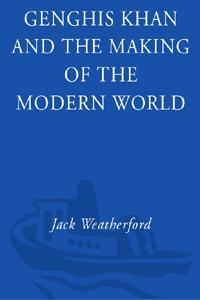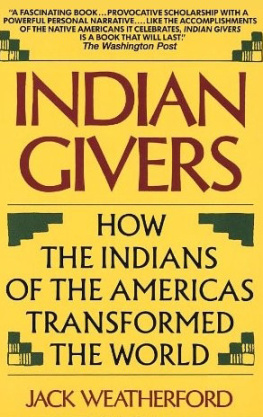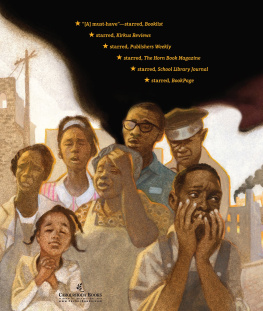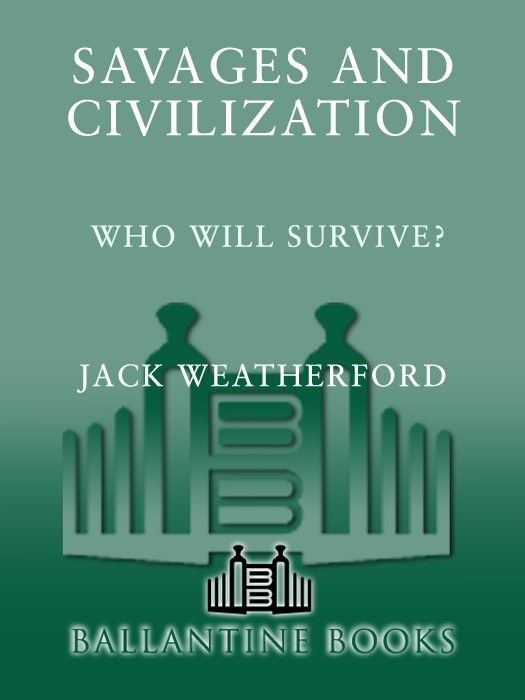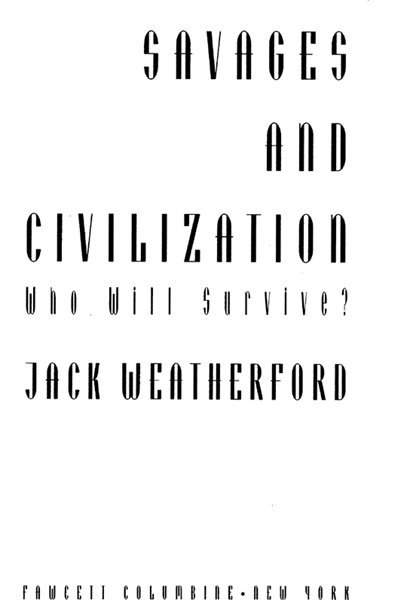A LSO BY J ACK W EATHERFORD
Tribes on the Hill
Porn Row
Narcticos en Bolivia y los Estados Unidos
Indian Givers
Native Roots
Dedicated with appreciation
to
Marnie and Roy Pearce
Contents

I. TRIBAL CULTURE
and the Origins of Diversity
II. NATIONAL CULTURE
and the Rise of the Global Order
III. WORLD CULTURE
and Ethnic Chaos
Acknowledgments

I thank my wife, Walker Pearce, for accompanying me on the long quest to research and write this book, and I appreciate her thoughtful comments. I appreciate the constant encouragement of our children, Walker Buxton and Roy Maybank, as well as the twenty-five years of support from my wifes parents, Marnie and Roy Pearce, to whom this book is dedicated.
Since 1979 I have worked closely with my editor, James OShea Wade, and my agent, Lois Wallace, and I appreciate their years of advice and assistance.
At Macalester College, I thank Robert Gavin, Nancy Gibbons, Betty Ivey, Kathy Hyduke, David McCurdy, Anna Meigs, Anne Sutherland, the staff of the DeWitt Wallace Library, and mostly I thank my students for their many comments, suggestions, and criticisms.
I thank the W. K. Kellogg Foundation, particularly Bobby Austin, Norm Brown, Larraine Matusak, Russ Mawby, Betty J. Overton, Anna Sheppard, Roger Sublett, and the advisors and fellows of Group XI of the Kellogg National Fellowship Program. I appreciate the support of the Fulbright-Hays program at the American University of Cairo and the fellows who shared my experience in Egypt.
For special support along the way, I thank Roger Chilton, Virginia Greene, David de Havilland, Peter Johnson, Phil Lucas, and Stephanie Yoo, all of whom helped to make my travels more enjoyable.
P ART I
Tribal Culture and the
Origins of Diversity

The savage in man is never quite eradicated.
H ENRY D AVID T HOREAU
1
The End of the Modern World
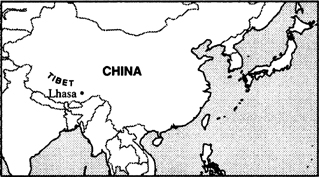
You cannot have both civilization and truth .
I RIS M URDOCH
S o many broken bones littered the Tibetan field of the dead that I had to dismount from my bicycle to avoid puncturing a tire on one of the sharp, splintered ends sticking up from the dirt and rocks. All around me, strips of worn and faded cloth scattered across the ground in the light breeze; they fluttered like miniature prayer flags from bushes or lay wadded in inert lumps among the rocks. In every direction I saw the broken and shattered remains of human bones that one could barely identifyfemur, tibia, rib, and occasionally a smashed skull or jawbone with a few teeth intact.
As I picked my way carefully across the field, I headed for the source of the broken bones and teeth; I moved toward a distant rock that served as the butchering platform where special mourners cut up the corpses and fed the bloody scraps to birds that circled overhead in great numbers. Walking closer to the skyburial site, I could not avoid the thick, sour odor of death. As I started to climb the rock, I strained to find a firm hold for my hands and feet. Despite the worn grooves for hand- and toeholds in the rock, the boulders had a slippery coating of body fat and other liquids that had dripped from the platform for years and coated everything below it.
I found the sky-burial platform and the adjacent field of bones in the northern outskirts of Tibets capital city of Lhasa, less than a mile from the Sera Monastery, a major religious center founded at the base of Tatipu Hill in the fifteenth century. For nearly five centuries the Sera Monastery served as a Buddhist university with an unusual mission in a pacifist religion. The monastery trained a special corps of fighting monks whose martial-arts powers made them prized allies of many armies and political causes through the centuries.
The monks do not butcher the bodies of the dead; that task belongs to experienced body breakers or domdens. Working at dawn, they skin the body and dissect it, then hack it into pieces and crush the bones, which they mix with tsampa, the staple Tibetan flour made from roasted barley. The domdens then leave the chopped body parts for the hungry vultures, ravens, and kites that live around the field of bones and depend almost exclusively on human flesh for their diets.
Highland Tibet offers few possibilities for the disposal of the dead. Unlike their Hindu neighbors to the south, the Tibetans cannot cremate the dead because most of the country is well above the timberline, and what little wood it possesses has much more important uses. Unlike the Chinese, the Tibetans find it difficult to bury their dead in the ground, because much of the ground is frozen and filled with rocks that make digging extremely difficult.
Even though many traditional cultures around the world once exposed their dead to the elements or to animals, the butchering of the body and sky burial of the Tibetans is unique. Traditionally only wealthier Tibetans or important monks merited burial in a tomb that had to be cut from rock. Sometimes people disposed of the dead by throwing the bodies into the river, but the rivers proved too small, and the bodies floating in them interfered with the daily activities of drinking and bathing. Sky burial proved to be the most efficient way of disposing of the bodies without leaving them to rot or become mummified in the dry, cold wind of the mountains. Tibetans consider sky burial an honorable and generous way for the deceased to perform one more act of earthly good by feeding the birds.
The practice of sky burial over many centuries allowed the development of a sophisticated body of psychological and medical knowledge gleaned from the work of the domdens. Long before Western medicine had sufficient knowledge of the workings of the body, the Tibetans understood such complex phenomena as the operation of the circulatory system and the development of the embryo. This knowledge seems surprisingly akin to modern science in that Tibetans saw the human being as passing through stages as fish and reptiles before becoming human.
Sometimes monks used human bones for other purposes, such as a trumpet used in exorcism, made from the human thigh bone, or a small drum made from a human cranium. Even though these human artifacts had ritual and religious purposes, the monks who used them seemed well aware of their impact to inspire fear in a poorly educated nation of village peasants and nomadic tribes. The Chinese communist government later put these instruments to propaganda purposes and used them to justify their claim of having liberated the Tibetans from their harsh and unjustifiably cruel theocracy.
Religion and politics overlap and intertwine in most societies, but in the history of Tibet, religion and politics have traditionally been the same enterprise. Through the centuries, monks, lamas, and abbots ruled the mountainous nation and guided it through successive religious feuds, purges, revolts, and wars. In the twentieth century, religion has been a major flashpoint in the struggle between the Tibetans and their Chinese rulers.


